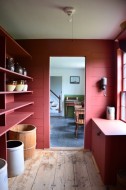.jpg)
THE BOYS IN BLUE (Part 1)
February 23, 2014
The image of a sweet 1890s farmhouse appeared on a computer screen in the John Jermain library in Sag Harbor, New York. I was searching for a home we could call our own. It’s lovely hipped roof and central front door reminded me of a simplified version of a grand British Georgian. Though our original notion was an 1840s Federal in bayside Eastport (like those we had come to love in bayside Sag Harbor), there was just something about this 8 ½ acre farm on the Golding Road, on a lake, in the woods, that I just couldn’t shake. It was at the top of a list of homes we planned to look over on a brief exploratory expedition that would take us from the ‘tony’ and high priced Hamptons to a rural and unspoiled Down East Maine. The reality represented by that haunting image would soon become a crucial part of a huge life changing decision.
We couldn’t see it until the second day of house hunting which was absolutely torturous, especially after a first day round of Eastport disappointments. It was on our one and only walk-through that we first heard the name Rob Golding. When we mounted the back staircase we saw a stack of turn of the century frames left by his family. Among them two large hand painted photo portraits of a young man - one in a uniform and one without. They were portraits of Robert Nathaniel Golding, the oldest son of our homes builder’s, Nathaniel and Mary Golding.
We were interested in the history of the farm and the family that lived there, so we asked the real estate agent if there were any relatives of the Golding family, who could fill us in. She thought our next door neighbor would be the best source. We had already done some initial internet digging from Sag Harbor, coming across some now familiar names in the Golding Cemetery in a publication, At Rest in Perry, Maine, posted online. Day two on the farm, we took a walk across the fields and through the treeline to Leona’s cozy 1820s cape and introduced ourselves to one of Perry’s most irreplaceable town treasures.
Leona Kendall had lived on the farm next door since the early 1930s when she married into the Golding family. Her husband, Everett’s father was Samuel Kendall and his mother was Georgiana Golding. Georgiana was a sister to our home’s builder, Nathaniel. She inherited the farm from her parents, since her brother’s all had their own farms down the Golding Road. Their parents, Robert and Martha, first purchased the place in 1854.
Leona poured cups of tea, shared the first of many homemade doughnuts and started to fill us in. She had done her own bit for the family genealogy years before and was the keeper of documents and photographs that went back as far as 1830. She disappeared into a closet and came back with a shoebox full of antique photographs. One that stood out and caused some excitement was a circa 1910 photo of our farmhouse; in the foreground a wagon loaded with people and luggage, drawn by a pair of horses, possibly poised for a trip to the Perry train station. She made us feel more than welcome and showed her natural generosity when she presented it to us as a house warming gift.
She let us borrow many more to make copies. Several we put into frames and hung in our dining room. One was a seated portrait of Nathaniel and Mary, another of their children (both taken on the farm) and a third, a carte-de-visite of a handsome young Rob in a military cap and uniform, professionally taken at the Bond photographic studio in Augusta. She told us that Rob had done a stint in the Spanish American War. Tradition has it her husband, Everett, built the 1935 addition to our 1890s home, paid for with money Rob saved from this service. He made $15.60 a month; didn’t smoke, didn’t drink and didn’t gamble. When other soldiers were spending their money, he was lending his and then getting it back with interest.
Later we would have the unexpected opportunity to hear Rob himself, fill in more of the story. Though he died in 1969 at the ripe old age of 93 he left a precious legacy in the form of a recorded oral history. Hunter, guide and raconteur; there are interviews archived at the University of Maine Folklife Center in Orono, conducted by his longtime friend, Thomas Archibald Stewart (there is an international airport named after Stewart in New York). They provide a rare glimpse into life here in 19th century rural Maine, family stories and recollections of his time in the Spanish American War. “Archie” affectionately called Rob, “Colonel Golding” in respect of his stature and service.
According to the official record, 22 year old Robert N. Golding, enlisted in the 2nd Infantry Regiment, Company I, of the Maine National Guard, on July 11th, 1898, in Eastport - just ten days after Theodore Roosevelt’s decisive victory at San Juan Hill and eight days after the destruction of the fleeing Spanish fleet at Santiago de Cuba Harbor. On April 22nd,1961, in Archie’s Grand Street home in Newburgh, New York, during one of many such recording sessions, Rob told his story;
“There was a fella in Eastport enlisting men for the Spanish American War so I decided to go. I went down and enlisted and Charlie Ferson, the blacksmith, went along with me, but they turned him down because he had a big bunion on his toe. The fella told me I didn’t pass the examination because I was too tall for my heft, but I passed so good in the examination otherwise if I wanted to go he’d pass me.
I was about the last one to go to the armory to get uniforms, and everybody else had picked out what they wanted, consequently I didn’t fare well. My coat fit me alright, but the pants was the right length but they was big enough for a fellow who weighed two hundred. I tied the belt loops together behind with string and fastened them in front Well they didn’t look too bad in front but they stuck out quite a ways behind.
And, then they mustered us, well they didn’t muster us in there, they mustered us in Augusta, but I fell in with the rest of the bunch. We got aboard the steamer there at Eastport and went to Portland, took the train from Portland to Augusta. They mustered us in up at Augusta and we spent three months there training.”
“What sort of uniform did you have?”
“Why we had blue, a dark blue coat and buttoned right up tight and we had a wool - heavy wool shirt that was heavy enough for winter."
“Wasn’t that rather hot in the summertime to drill?”
“Well yes and they made you button your collar right up and button your shirt up and we had blue wool pants with a white stripe up the seam. And I never drilled any, I was awkward as the day was long. And we got out in the field and we marched and I was in the rear rank. And I got out of step and the fella in front of me - every time his leg come back, I stepped on it. And when the next one come - leg come back - I stepped on that. And he was on - we were on the run - but we [were in] close marching order. Then he says, 'Get offa me you god damned farmer!' I never knew who he was, I (laughing hard) - I certainly was tramping on him…”
Click here for Part 2, Part 3 & Part 4
Thanks to the University of Maine Folklife Center and the St. Croix Historical Society.
(click photo to view larger image)
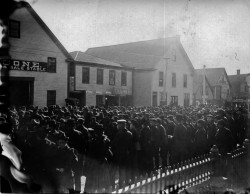
|
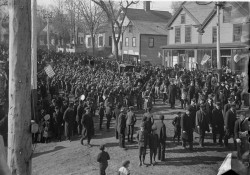
|
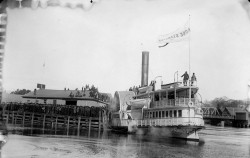
|
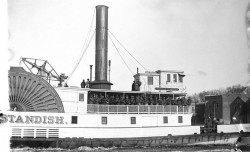
|
(comments = 1)
Interesting; thank you. Hope to see more.
leave a comment

fineartistmade blog
A journal about home design, gardening, art & all things Maine. Read more...
- June 2025
- December 2022
- November 2022
- October 2022
- November 2021
- May 2020
- October 2019
- August 2019
- July 2019
- September 2018
- April 2018
- December 2017
- August 2017
- June 2017
- May 2017
- December 2016
- August 2016
- July 2016
- April 2016
- November 2015
- June 2015
- May 2015
- March 2015
- October 2014
- March 2014
- February 2014
- January 2014
- December 2013
- November 2013
- July 2013
- May 2013
- April 2013
- March 2013
- January 2013
- December 2012
- November 2012
- August 2012
- June 2012
- April 2012
- March 2012
- February 2012
- January 2012
- December 2011
- October 2011
- August 2011
- July 2011
- June 2011
- May 2011
- April 2011
- March 2011
- February 2011
- January 2011
- December 2010
- November 2010
- October 2010
- September 2010
- August 2010
- July 2010
- June 2010
- May 2010
- My Scandinavian Home
- Daytonian in Manhattan
- {frolic!}
- I Married An Irish Farmer
- Smitten Kitchen
- The Curated House
- even*cleveland
- Mary Swenson | a scrapbook
- Ill Seen, Ill Said
- Gross & Daley Photography
- Remodelista
- Abby Goes Design Scouting
- Mint
- the marion house book
- 3191 Miles Apart
- Svatava
- Katy Elliott
- Poppytalk
- Kiosk
- decor8
- KBCULTURE
- Lari Washburn


